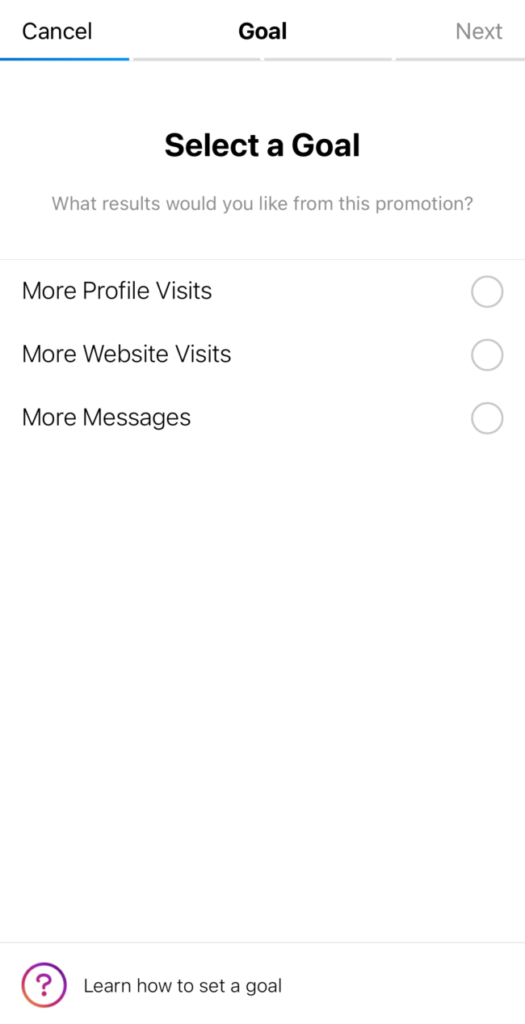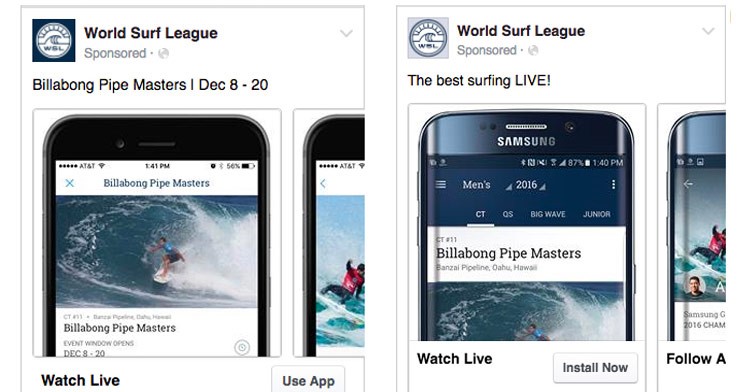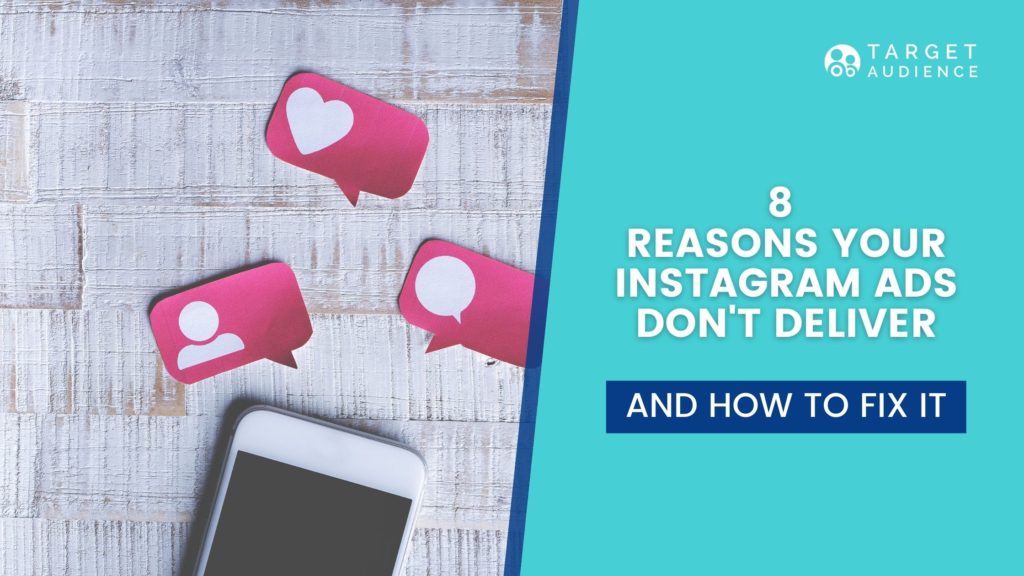With 1.2 billion active users worldwide, Instagram is one of the most powerful advertising platforms. But not all Instagram ads have an equal chance of success, and sometimes, your Instagram ads don’t deliver the results you were expecting. If you have been advertising on the photo-sharing app for a while but are underwhelmed by the results, you may make one of the common mistakes in this article.
We listed 8 possible reasons your Instagram ads don’t deliver the desired results, whether engagement, traffic, or conversions, alongside actionable solutions that will help you nail your future Instagram campaigns.
1. Your objective is unclear
A common mistake advertisers make with Instagram campaigns is choosing the wrong objective. The objective you set tells Facebook which action you want people to take on your ad. This helps the algorithm determine who to serve the ad to and the time and place they see it.
Each objective column corresponds to a specific stage in the sales funnel (awareness – engagement – action). It’s important to think over this step carefully because once you set an objective for your campaign, you won’t be able to change it later.
The more precise you are about the goal of your ad, the more effective it will be. “Increase revenue,” for example, isn’t going to get you far because it’s too general. How exactly do you want to achieve this big-picture goal? Here are a few examples of more focused objectives:
- Increase user engagement
- Drive traffic to your website
- Increase sales or app installations

Let’s say you chose example no. 3 as your goal. A person could be scrolling through Instagram at 7 AM while laying in bed, still sleepy. Or at 5 PM while waiting for the train home. At these times, they might like some posts, watch some videos, and even comment, but opt-in and buy something? Not so much.
So if you’re aiming for conversion, make sure to choose an objective from the Conversion category. That way, Facebook will target the people who are most likely to convert, based on their behavior patterns to date. “Traffic” or “Engagement” may get you more likes and followers, but if a direct sale is what you want, the results will be underwhelming.
2. Your target audience is not defined properly
The campaign objective helps determine to whom, when, and where your Instagram ad is served. Audience targeting is mostly responsible for the “who” part. After all, even the most fantastic ad won’t deliver if it reaches the wrong audience.
Facebook Ads Manager allows you to target by demographic, interest, and occupation extensively. But you can target your audience with even greater precision. Behavioral targeting, for example, allows you to include or exclude users from your audience based on their behaviors, from where they last traveled to whether or not they drive a car.
For example, you can target engaged shoppers who have hit the Shop button in the past 7 days but exclude lower-income households. To learn more about how Facebook can help you with targeting, check out our guide to creating the perfect FB ad.
Once you build a solid custom audience (preferably one with at least 1000 members), you can start creating lookalike audiences. This is the first step to scaling.
3. Not using Facebook Ads Manager
Did you notice how many times we mentioned Facebook Ads Manager so far? Setting your Instagram ads directly through Instagram is possible, but it’s certainly not the best way. Not utilizing Facebook Ads Manager can be one of the main reasons why your Instagram ads don’t deliver.
Tapping the blue promote button on an existing post you want to boost can be tempting but it’s not worth it. Once you tap the promote button, you will be given 3 options to choose from:
more profile visits
more website visits
more messages

What about more post engagements? Or more leads? None of those important objectives we talked about are available here. Facebook Ads Manager has a much wider range of settings, and if you don’t utilize them you are limiting your own campaign. Here are some of the benefits this platform has to offer:
- You can have more control over your budget
- You can be more precise in targeting your ideal audience
- It’s possible to create Instagram Stories ads
- You’ll be able to analyze your campaign in depth
4. Not focusing enough on video
Instagram started as a platform for sharing static square images, but times are changing. The presence of video on the app is becoming increasingly significant. A recent study by ReverseAds found that “Video ads generated over triple the leads compared to static images and generated 25% more impressions. People respond to and engage with video better than static images.”
Adam Mosseri, the head of Instagram, stated that the app is moving away from being a “square photo-sharing app,” as he put it. Instagram is putting a lot of emphasis on video content, like IGTV and reels, and is aiming to be thought of as a “general entertainment app”.

So if you’re not making sufficient use of video in your IG ads, it’s time to start. Instagram launched Reels Ads in the summer, and according to their statement, it’s the best place to reach audiences that don’t follow you. This platform, which is slightly different in spirit than stories, allows greater creative freedom to show the fun and quirky side of your brand. So as much as the purpose of your Reels ad is to generate traffic, clicks, or leads, make sure to keep it fun, and never too sales-y or pushy.
5. Not adapting the ad layout to the placement
Instagram has a variety of placements for your ads. Feed, stories, and reels all have different dimensions and should be treated separately. For example, if you’ve created a video ad to post on your story, it will need some work before you can post it on your feed too. You don’t want to post an ad with your head cut off or with text coming off the screen, right?
When you’re in Facebook Ads Manager, if you hover your mouse over the different placement options, both on FB and IG, it will show you a preview of how the ad will look. That way you can adjust and resize it so it’s effective in different placements.
A few important pointers to remember:
Feed Ads – A feed ad has to be a .jpg or .png of a maximum of 30MB if it’s an image or 4GB if it’s a video. Videos have to be square or vertical and can last up to a minute.

Stories Ads – In Stories the layout should be vertical and the size of the images 1080×1920. Each photo will be visible for five seconds. You can use a maximum of ten carousel cards; and each carousel video will last 15 seconds, while a prompted carousel video lasts 60 seconds to 120 seconds.
Reels ads – Instagram Reels ads, like regular Instagram Reels, are between 15 and 30 seconds in length. As for the dimensions, the aspect ratio for a Reels is 9:16 and the ideal file size is 1080 x 1920 pixels. Make sure your files fit this standard, otherwise they can look blurry or awkwardly cropped.
6. Not testing enough
With so many analytic tools at your disposal, you really don’t have to leave anything down to luck. Don’t underestimate the importance of A/B testing. It’s a powerful tool for discovering the specific elements your audience responds to.
You can A/B test your ad’s creative elements or your audiences. Testing the creative side could mean using the same copy across four different ads but pairing it with a different image or video in each to see what performs best.
Testing your audiences means publishing two identical versions of an ad to two different but comparable audiences.
Only running 1 or 2 ads, or delivering them to no more than one audience is a no-no. The more you test the more insight you gain on what exactly will bring you the desired results.

7. Neglecting your landing page
A good ad is just the first step in a user’s overall experience with your business. You may have a great ad that sends prospects to your landing page, but if that landing page is confusing or intimidating, the lead may be lost.
Make sure that your ad and landing page match in visual language, the tone of the written copy, and the message, of course. It’s best to create a custom landing page for each ad, rather than making a single, general one.
Your landing page needs to deliver on what your ad promised. So, if your ad talks about a discount code, it should be one of the first things mentioned on the landing page. This will create a seamless experience that increases the chances of turning a click into a sale. If you want to learn more about landing page optimization, we’ve got you covered.
8. Giving up too soon
So you’ve launched an ad, followed all the best practices, and fixed all the mistakes mentioned above. And still no results. Don’t be discouraged. Instagram ads are not immediate.
It can take about 3 months of initial testing before you start seeing results. And usually, even longer for profitable, sustainable results. So be patient and give your ads enough time to be tested truly.
Final Thoughts On What To Do When Your Instagram Ads Not Delivering
The basis of a good Instagram ad is one clear objective and a clearly defined target audience. The more precise you are about these factors, the more effective Facebook’s optimization will be.
Instagram has a variety of placements, each with its advantages. Be sure to deliver quality content across all placements—feed, stories, and reels. Each demands slightly different styles and dimensions, so always make sure your ad is adjusted before you post it. Otherwise, you risk looking sloppy. Most importantly, invest in fresh, creative, and engaging video content.
Remember, this is going to be a process. You’ll work your way through it several times as you launch and scale a new ad campaign. Your ads will become more accurate and precise with each round of testing. Long-term success requires you to be in it for the long haul.



